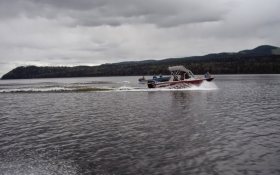Babine Archaeology Project 2014
Babine Archaeology Project 2014
F. Rahemtulla
The LBN/UNBC 2014 Babine Archaeology Project began on Aug 10 and will continue to run until Aug 31. Funded by the LBN Treaty Office, the project is once again under the direction of Dr. Farid Rahemtulla of UNBC. The project team consists of four LBN community members (Frank Alec Jr., Julian Brown, Cordell Lowley, and Donovan Williams) and four experienced university students (Brigitte Aubertin, Graeme Barber, Emily Hails and Seraphine Munroe). The goal of the project is to recover as much archaeological information as possible during the three weeks, and also to provide training to the LBN community members. The entire team is staying at the Ft Babine Lodge or at Ft Babine.
Previously the LBN/UNBC partnership conducted archaeological work in 2010 and 2012 at the village next to the fish counting fence, several kilometers north of Ft. Babine. As indicated in reports submitted to the Treaty Office, the village is at least 1,300 years old and one excavated house dates back at least 600 years. The village was in use long prior to the arrival of the Europeans and continued to be used until the 20th century. Artifacts uncovered ranged from stone projectile points to musket balls and flints, to modern firearm cartridges. There is also strong evidence that some types of stone (especially obsidian) were traded in from several hundred kilometers away.
For 2014 the project is centered on Smokehouse Island in the Babine River. This involves three weeks of testing and excavations on the island, which has never been done before. So far the team has recovered a very high volume of stone tools and manufacturing debris from the shovel tests and excavations. The density of these stone tools is very high and unexpected for a small island where catching and processing fish has likely always been an important activity. There is quite a variety of stone raw materials, which could reflect import through trade networks. Many of the stone flakes are also unusually large in size although more work will be done on this in the lab. Adjacent to the island there are also wood stakes in the water, which are remains of the traditional fish weirs (barricades) that people used for generations. These will be mapped in and samples will be taken for possible radiocarbon dating. After the excavations are over several months of analyses will take place at UNBC, where the stone tools and anything else recovered will be carefully examined and radiocarbon samples will be sent out for dating. A report will be submitted to the LBN Treaty Office in 2015.





